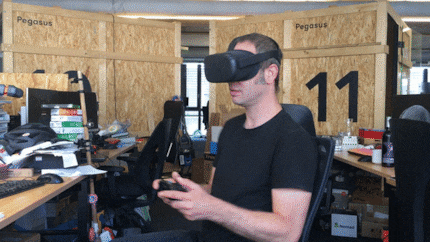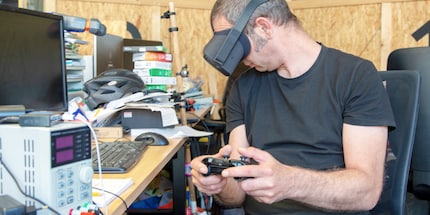
Product test
Oculus Quest vs. Rift S: Always a compromise and yet there is a winner
by Philipp Rüegg

I bought the wireless Oculus Quest. With the aim of using it primarily with my PC. In this article, I'll explain whether it's worth it and how to do it. It's not particularly complicated, but there are a few pitfalls along the way.
Oculus recently launched the new generation of VR glasses. Our colleague Philipp Rüegg tried out the Rift S and the Oculus Quest. Phil's conclusion: There is one winner - the Oculus Quest. Reason: The standalone glasses are completely wireless and the resolution of 1440×1600 (per eye) is surprisingly a little better than that of the new, wired Rift S. The Quest also scores with AMOLED displays, while Oculus relies on LCD for the Rift S.
With its Android apps, the Quest can't hold a candle to the Rift S and the PC. According to Phil, the graphical differences in games that are available on both platforms are limited. What's more, Phil wrote that there's a trick you can use to get the Oculus Quest to work with the PC. I really wanted to try that out.
Is it worth it? Yes! Playing Subnautica in the middle of the room rather than at a desk is a new experience. Spinning around on my own axis on the swivelling office chair to get a quick overview - it's sheer madness. A completely new VR experience.

Subnautica was already my favourite game of 2018 without VR, but with VR it's a whole new experience. Down in the pitch-black depths, you get goosebumps. The omnipresent breathless situations are even more oppressive. But it's even more fun to build a cosy underwater house among the phosphorescent anemones.
But first things first.
The Oculus Quest is a standalone VR headset. They are equipped with a Snapdragon 835 running a proprietary version of Android.
Around 50 apps are available for the Quest in the Oculus Store. In contrast to the previous Windows apps, these are newly developed Android versions. The big hits such as Beat Saber, Vader Immortal and Superhot VR are included.
Almost all apps that you may have already purchased for another Oculus version will have to be bought again for the Quest. Apps usually cost between 10 and 30 francs. The publishers argue with the development effort for the native Android apps. This is somewhat understandable, but remains annoying.
The Quest has Wi-Fi and can also stream. There are already countless breathtaking 360° productions on the still young YouTube VR. If the Quest can stream videos, then surely it can also stream content from a PC, right? So it makes sense for me to have my VR games calculated by Steam VR on the powerful gamer PC and beamed to the Quest.
The Quest is very powerful and offers a lot of gaming fun in its ecosystem. It is not intended to be used as a dumb playback device. On the contrary: this is not in Oculus' interest due to the separate app store. The company is already showing a certain interest in separating the worlds. The Virtual Desktop app in the official store, which enabled streaming from the PC, was neutered by the developer under pressure from Oculus so that it no longer supports Steam VR. (Incidentally, this is what the Oculus Community thinks.)
.
Because it is no longer officially supported, you have to use unofficial programmes to stream from your PC to the Quest. There are several apps that do the job. What they all have in common is that you have to sideload them. In other words, you don't download packages from the Oculus Store, but from other sources. This is not illegal, but it is not the way Oculus intended. For this to work, you have to apply to Oculus to be allowed to switch your Quest to Developer Mode.
First, you need to activate developer mode in the companion app for the Quest on your Android or iOS device. To do this, you must register a developer company with Oculus. Oculus is currently simply waving applications through. In other words, it really is that simple: after the basic setup - which requires registration with the Facebook subsidiary Oculus anyway - you simply go to developer.oculus.com/organisations/create and create a company. XY Solutions, Fantasy Inc, Megabug Softwarez - everything is accepted without complaint. As soon as you apply for developer mode, you have it. It takes less than five minutes.
Then it's time to sideload. There are two common programmes for streaming Steam VR to wireless glasses such as the Quest: ALVR (free) and VRidge from Riftcat (15 US dollars). In terms of performance (latency), ALVR is reported to have the edge. When it comes to choosing the right codec (HEVC), the two don't have much in common in my opinion. VRidge is easier to use, offers more options and is being actively developed further.
The one-time installation in a nutshell:
You can find detailed instructions here (VRidge) and here (ALVR).
Two steps are necessary to play:
Both ALVR and VRidge start SteamVR automatically on the PC. You will then see the Steam VR interface on the Quest, which you can use to start the desired game.
If you want to stream from your PC to the Quest, you need to have your Wi-Fi under control. The router must be positioned correctly and you should have as little competition as possible on the selected channel. Streaming at high resolutions requires a lot of bandwidth. VRidge recommends 20 - 25 MBit per second. More is of no use in terms of quality and increases latency.
In theory, even a 2.4 GHz WiFi with a transfer rate of 54 MBit/s can cope with this. In practice, I recommend using a 5 GHz channel. The access point must be in the same room as the glasses and PC. The stream works perfectly for me in the same room as the access point. I did the test and positioned the PC and Quest around two corners. The result was image artefacts and severe hangs. Not recommended for VR: sensitive people will find this literally vomit-inducing.
Ideally, the PC is connected to the router via cable. WiFi is - in contrast to wired Ethernet - a half-duplex medium. WiFi can either transmit or receive, but not both at the same time. If the PC is not transmitting, not only is the radio traffic halved, the access point can concentrate on sending to the Quest.
A lot of fuss has been made about the frame rate in the past. It was said that 120 Hz should be the target. Below 90 Hz would cause discomfort. I agree in principle: more is better. On the other hand, the problem doesn't seem to be that bad. After all, Oculus itself has gradually reduced the frame rate:
I also find the Quest's 72 Hz quite acceptable. Longer sessions - I'm already looking forward to a session of Space Truckers Elite Dangerous - will show whether the Quest was a mistake. So far I don't see any problems.
I found the very popular 360° video of Angel Falls to be suboptimal. It is available in resolutions up to 8K - but with far too few FPS. It's jerky, and that's the case on every VR headset because the production company messed up.
That's how it should look, then there won't be any problems:
Latency, i.e. the time delay between moving the head and the display on the quest, is also very important for VR glasses. Latency is already an irritant for hardcore gamers. In the case of VR, latency also has a significant influence on the nausea factor. The higher the latency, the more confused the extremely sensitive organ of balance becomes. Milliseconds make the difference between "good" and "no go".
The task of streaming is not easy and requires a lot of computing power, especially from the graphics card. The task is already complicated when playing back on wired VR glasses: instead of a single image, two must be calculated for each eye. The transmission takes place via HDMI cable and directly addresses two displays.
In the case of streaming
This means that games that place a heavy load on the graphics card or CPU are not suitable. I would also not recommend games where speed is important.
With ALVR and VRidge, the feat is achieved in around 65 milliseconds. That's a lot in the VR world. Even lower latencies can make sensitive people feel sick. I seem to be rather insensitive to this. If you are sensitive to latency, it is better to use a wired headset.

After the first few hours of play, it's clear to me that I made the right decision. With the Oculus Quest, I have bought a VR headset that offers me solid standalone gaming fun. Technically, it is slightly superior to the Rift S with its higher resolution and, above all, the AMOLED displays. With the streaming trick, I can also tap into the world of PC gaming.
There is still a residual risk. If Oculus wants to, the allocation of developer accounts could become much more difficult overnight. Not only that, as with all always-connected devices, permission can also be withdrawn retroactively. Just as Elon Musk can stop all Teslas with a software update, Oculus can subsequently ban me from using my PC.
It remains to be seen how Oculus will react if there are suddenly a lot of Quest buyers outside of the store. The fact is that it works now and that the wireless VR experience is much more immersive. Spatial freedom combined with the power of your gaming rig is a quantum leap. At least if, like me, you can cope with the higher latency and lower refresh rate.
I don't want to recommend my solution unreservedly. However, for me it is by far the most elegant VR solution with acceptable compromises I would do it again and put the Quest over my head again. Just one more quick 360° video to watch. I swear!
I'll be happy to get back to you with a long-term test if you're interested.
I'm the master tamer at the flea circus that is the editorial team, a nine-to-five writer and 24/7 dad. Technology, computers and hi-fi make me tick. On top of that, I’m a rain-or-shine cyclist and generally in a good mood.
Practical solutions for everyday problems with technology, household hacks and much more.
Show all